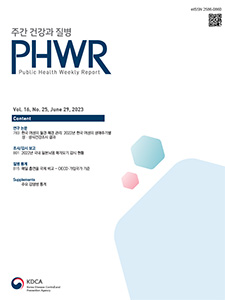Current Issue
Vol.16 No.25, June 29, 2023
-
Original Articles 2023-06-29
 2
2
 3869
3869
 295
295
How Do Korean Women Manage Menstrual or Menopausal Symptoms: 2022 Women’s Health Survey for Sexual and Reproductive Health
Eunsol Song, Eunja Park, Seung-Ah Choe, Juhyun Park, Bo Mi Song, Kyunghee Han, Hyun-Young Park
Public Health Weekly Report 2023; 16(25): 783-800 https://doi.org/10.56786/PHWR.2023.16.25.1 Abstract
AbstractMenstrual health and hygiene are important for health and well-being across the life course. To assess sexual and reproductive health among Korean women, we conducted an online survey with 3,098 adolescent girls and premenopausal women and 1,307 peri- or post-menopausal women from July to September 2022. Among premenopausal women, 43% reported severe dysmenorrhea and 46% experienced severe premenstrual syndrome. Women who were menopausal or peri-menopausal reported health problems including sleep problem (28.0%), joint/muscle discomfort (23.3%), and vaginal dryness (27.2%). However, only 9.9% of adolescents and 28.5% of adults attended health services for these menstruation disorders. Moreover, 19.5% of peri- or post-menopausal women received medical treatment for menopausal symptoms. This result suggests that better access to service for menstrual health or menopause management may help promoting sexual and reproductive health and overall well-being among Korean women.
-
Surveillance Reports 2023-06-29
 2
2
 2578
2578
 482
482
Monitoring Japanese Encephalitis Vector Mosquitoes (Culex tritaeniorhynchus) in the Republic of Korea, 2022
Soeun Shin, Sehoon Cho, Hyunwoo Kim, Wook-Gyo Lee, Hee-Il Lee*
Public Health Weekly Report 2023; 16(25): 801-814 https://doi.org/10.56786/PHWR.2023.16.25.2 Abstract
AbstractDivision of Vectors and Parasitic Diseases in the Korea Disease Control and Prevention Agency (KDCA) supervises projects with the Institute of Health & Environment Research to monitor the occurrence of Culex tritaeniorhynchus, a vector of Japanese encephalitis ( JE). Mosquitoes were collected by operating black light traps at 11 collection areas across the country from April to October 2022, and the number of collected mosquitoes was calculated daily occurrence (mosquitoes/trap/day). Cx. tritaeniorhynchus was first collected on April 11, 2022 from Busan, which led to the warning of precautions against JE. On July 23, 2022, a national warning was issued. Because more than 50% of the collected mosquitoes in Busan were Cx. tritaeniorhynchus. In the 2022 collection period, 116,340 mosquitoes of 18 species were collected. Of them, 20,340 were Cx. tritaeniorhynchus, indicating a 16% increase from 2021 when 17,528 mosquitoes were collected. The appearance of Cx. tritaeniorhynchus is gradual from June and persists until October, occurring in a high density between July and September. The southern area was denser than the northern area, and the population density of Cx. tritaeniorhynchus was the highest in Gyeongnam. These results were posted on the KDCA website (http://www.kdca.go.kr) to aid in the prevention and control of Japanese encephalitis.
-
QuickStats 2023-06-29
 0
0
 1731
1731
 225
225
International Comparison of Daily Smokers with OECD Countries
Public Health Weekly Report 2023; 16(25): 815-816 https://doi.org/10.56786/PHWR.2023.16.25.3

pp. 1433~1461
Most Keyword
?
What is Most Keyword?
- It is the most frequently used keyword in articles in this journal for the past two years.
Most Read
-
Waterborne and Foodborne Disease Outbreaks in the Republic of Korea, 2023
Myung-Jae Hwang, So Yeon Park, Hyungjun Kim, Se Jeong Yang, Sungchan Yang, Jin Seon Yang
Public Health Weekly Report 2025;18: 17-32 https://doi.org/10.56786/PHWR.2025.18.1.2 -
Implementation Plan for the Coronavirus Disease 2019 Vaccination for the 2024–2025 Season: Recommendations of the 6th Expert Committee on Immunization Practices
Hyewook Hwang, Wookeon Lee, Seohyeon Ahn, Young-Sook Choi, Seunghyun Lewis Kwon, Dongwoo Lee, Eun Hwa Choi, SokGoo Lee
Public Health Weekly Report 2025;18: 90-102 https://doi.org/10.56786/PHWR.2025.18.2.3
Editorial Office
+82-43-719-7569





 Full Text
Full Text Cite
Cite


